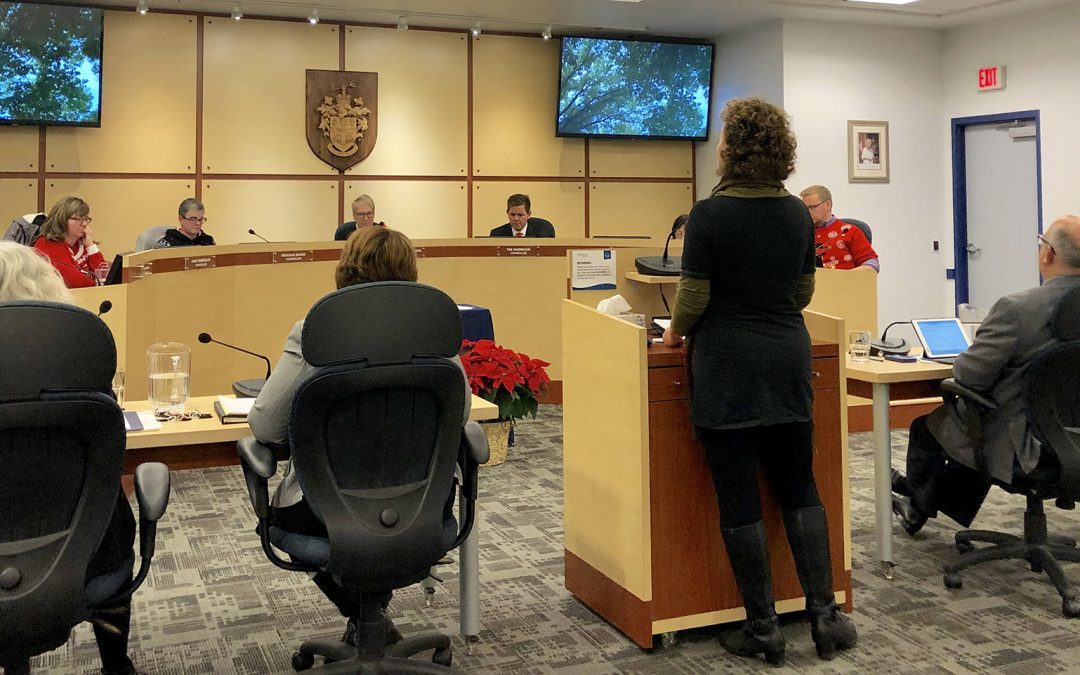Thank you mayor and council for your service to our community and the opportunity to address you.
I’m here on behalf of the Community Trees Matter Network and the Creatively United for the Planet Society.
We’d like to thank the Township and staff for being proactive on the creation of an Urban Forest Management Plan.
Hopefully while deliberating your upcoming budget, there will be enough funding to ensure the recommendations in the Urban Forest Master Plan are fully implemented, especially sections 5.4, 5.5, 5.6 and 5.7 with the direction of the township’s senior arbourists, to ensure as many mature trees as possible are protected, preserved, and appropriate trees are planted with adequate soil volumes, watering and maintenance to ensure they survive and thrive.
Our natural environment – that includes a variety of trees, not planter boxes – is why tourism is the number one economic driver in BC and why many of us chose to live in this municipality. With all due respect, anywhere can look like Richmond.
I’ve lived and worked in Esquimalt for 32 years. I’ve seen a tremendous number of trees lost in recent years, including in our beloved parks where once quaint forest pathways have become wider and wider at the expense of trees, so wide that vehicles can drive on them.
At one time, builders worked around trees. A shining example of that in Esquimalt is Charlie Velikovsky’s Drake Street development. By working around the Garry Oak ecosystem and rock outcroppings, he created a development that brings a lot of value to the street and area.
The most coveted neighbourhoods are generally those with the most trees and natural features. Today, builders scrape the land bare of every earthworm and living thing, without regard to how this impacts the natural ecosystem and surrounding neighbourhood.
It can take 269 saplings to replace the many benefits of one mature tree! People who live on streets and in neighbourhoods without trees have a higher rate of asthma than those that do. Trees are a public health matter.
- Trees are the hardest working member of our communities. For no pay, they work 24/7 and are always on the job to clean the air and soil, create oxygen, store water, prevent erosion, buffer the wind, cool the air in the hot dry summers, and mitigate the effects of storm water. They make us feel good mentally and physically. They provide shade, shelter and habitat for wildlife, and some give us food.
- And trees get better at their jobs, the older they get. And when they do start to decline, they are still useful. They can become wildlife trees. Their fallen bodies can become fertile ground for new tree growth.
- For every dollar spent, trees give back multifold in community benefits. For example, Esquimalt’s street tree resource intercepts 11,650 cubic meters of stormwater annually, for a savings of $85,252 or $18 per tree.
- Approximately 16,209 people live in Esquimalt and $20 per citizen is spent on trees each year. What a deal!!! That’s less than the cost of two people going to a movie.
- You would think this would qualify trees for an award or two, some respect, reverence, or at least some protection. Instead they are axed, removed, summarily dismissed or seen as problematic when new projects are planned.
If we finally took climate change seriously we would be rewarding developers who understand the benefits of working with nature, not against it.
With the continued loss of thousands of our established urban trees, the impact of smoke-filled skies in our region for three consecutive summers, and the UN Intergovernmental Panel on Climate Change (IPCC) report calling for immediate action it’s time to value our trees as the assets they are.
We have to take a more managed approach by attracting sustainability experts with creative long-term goals and vision vs profiteers in it for the short term gain.
The reward is we all win. Affordable housing can still be very much part of that equation.
A few suggestions:
- Perhaps public works research ways to detour sewer connections when valuable trees are at stake, such as using torpedo tunnelling technology, and include a budget item for the municipality to share the cost with the landowner.
- Provide more transparency with annual public reporting of a) permits approved and denied for tree removal by size, species and location, b) species and locations of new trees planted (not including those on rooftops or in containers), and c) annual canopy loss / gain.
- Prioritize the preservation of trees when planning new infrastructure and projects, including creating more permeable surfaces around trees, plant understory plants to aid in the health and survival of trees and help create biodiversity and begin an aggressive and comprehensive plan to get more trees planted to create a legacy for tomorrow.
- And, convene an Urban Forest Steering Committee / Advisory Group to assist with the review of best practices in other jurisdictions, including options for financial incentives to private landowners. Members of our organization would be delighted to lend our support and assist in whatever ways we can to attract volunteers willing to help plant trees.
We need trees more than they need us. In fact, trees would be doing a whole lot better without us around.
In summary, the social, health and economic value of trees is indisputable. Let us leave you with this video made for the City of Halifax that clearly demonstrates that Trees Matter!

excellent presentation.
Thank you Ms. Litman for encouraging and educating your local government about the value of trees within our communities. Hopefully there have been policy changes and improvements in managing Esquimalt’s urban forest in the last year and half since your presentation.